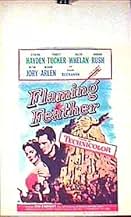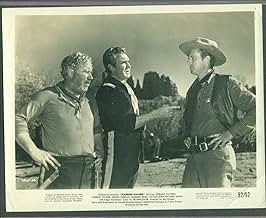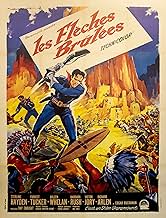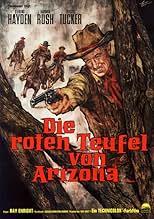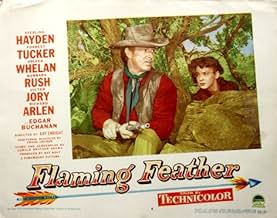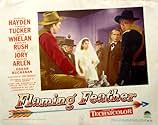VALUTAZIONE IMDb
5,8/10
463
LA TUA VALUTAZIONE
Aggiungi una trama nella tua linguaIn Arizona during the 1870s, rancher Tex McCloud and cavalry Lt. Tom Blaine race to capture the notorious Ute renegade outlaw leader known as the Sidewinder.In Arizona during the 1870s, rancher Tex McCloud and cavalry Lt. Tom Blaine race to capture the notorious Ute renegade outlaw leader known as the Sidewinder.In Arizona during the 1870s, rancher Tex McCloud and cavalry Lt. Tom Blaine race to capture the notorious Ute renegade outlaw leader known as the Sidewinder.
- Regia
- Sceneggiatura
- Star
Victor Adamson
- Barfly
- (non citato nei titoli originali)
Carl Andre
- Trooper
- (non citato nei titoli originali)
Rudy Bowman
- Townsman
- (non citato nei titoli originali)
Buck Bucko
- Barfly
- (non citato nei titoli originali)
Paul E. Burns
- Gold Prospector
- (non citato nei titoli originali)
Heinie Conklin
- Townsman
- (non citato nei titoli originali)
Don Dunning
- Trooper Condon
- (non citato nei titoli originali)
Recensioni in evidenza
I consider this western as one of my favorite from director Ray Enright, a western specialist from the forties, as also was Edwin L Marin, both proposing Randolph Scott for many of those westerns. Here, you have Sterling Hayden, instead of Randolph Scott and the result is flawless for me. Victor Jory as the villain is not a surprise but the film shows us many action scenes, splendid settings, photography, and a fast paced story. I have not seen this film since a long time and I don't regret to have seen it. The forties western from Warner Brothers and Paramount were better than in the fifties.
This a good picture for what it is. It seems to start out as a formula western with an age old plot, white man running with Indians doing bad things, lone hero sets out to stop him, etc. However the script is pretty good, there is some suspense, though we sort of know from the get-go who the bad guy is,the moment he shows on the screen. I love Sterling Hayden...for a guy who really didn't like being an actor, he does all right. Barbara Rush is beautiful and appealing. Forrest Tucker just shows up, and Victory Jory steals the picture with his oily charm.Edgar Buchannian is wasted in a role he really isn't suited for.
However, all in all, a pretty good picture. I enjoyed it.
However, all in all, a pretty good picture. I enjoyed it.
With the ' threat ' of television Hollywood assessed the situation, and drew in audiences with 3D films, Cinemascope and above all colourful Westerns, and the latter could be made on simpler budgets and no doubt this ' new ' formula helped to keep the ' threat ' away. ' Flaming Feather ' directed well by Ray Enright in his penultimate film showed landscapes in rich Technicolour and good enough actors to draw audiences in. As for the plot a man called the Sideliner with the help of a renegade tribe raids on settlers, causing many deaths. No spoilers as to the motive. Sterling Hayden ( well acted ) has his ranch burned down and counter attacks. It really is as simple as that, and he of course falls in love with Barbara Rush in one of her earlier roles. The ending I saw a mile off, no doubt along with many children in the cinema. Basic the film is but it along with others heralded the way for the great Westerns of the 1950's to come. Just for the sweep of the action in mythical landscapes this film is worth seeing, and laconic Hayden is always well worth watching.
Flaming Feather is directed by Ray Enright and written by Gerald Drayson Adams. It stars Sterling Hayden, Forrest Tucker, Arleen Whelan, Barbara Rush, Victor Jory, Edgar Buchanan and Richard Arlen. A Technicolor production, music is by Paul Sawtell and cinematography by Ray Rennahan.
The mysterious outlaw known only as The Sidewinder is in cahoots with the Native Americans and terrorises Arizona's settlers. But when The Sidewinder chose Tex McCloud (Hayden) as one of his targets, he hadn't banked on Tex linking up with the U.S. Cavalry to hunt him down.
Enjoyably energetic Oater that makes up for what it lacks in originality with gorgeous location photography and a barn storming finale. Ray Enright was a good old pro at this sort of thing, and here he doesn't waste any time with pointless filler scenes or drawn out conversations that don't advance the plot. From the get go we are thrust into an action sequence, and from there on in the film rarely pauses for breath.
Hayden and Tucker make for a beefy coupling, and although the mystery element is not exactly rocket science to work out, the presence of three lovely lady characters does spice up the intrigue surrounding The Sidewinder and those in pursuit of him. It all builds to a wonderful finale that starts out with a Little Big Horn type siege, which then develops into a pursuit and battle up at the Montezuma Castle Monument in Arizona, where fire pit punch ups and ladder skills enthral greatly.
It isn't hard to pick holes in it, it is after all one of those quintessentially early 1950s Westerns that was ignorant to intelligent scripting and screenplays. Yet for sheer gusto and consistently airy beauty this is a must see for Western and Hayden lovers. 7/10
The mysterious outlaw known only as The Sidewinder is in cahoots with the Native Americans and terrorises Arizona's settlers. But when The Sidewinder chose Tex McCloud (Hayden) as one of his targets, he hadn't banked on Tex linking up with the U.S. Cavalry to hunt him down.
Enjoyably energetic Oater that makes up for what it lacks in originality with gorgeous location photography and a barn storming finale. Ray Enright was a good old pro at this sort of thing, and here he doesn't waste any time with pointless filler scenes or drawn out conversations that don't advance the plot. From the get go we are thrust into an action sequence, and from there on in the film rarely pauses for breath.
Hayden and Tucker make for a beefy coupling, and although the mystery element is not exactly rocket science to work out, the presence of three lovely lady characters does spice up the intrigue surrounding The Sidewinder and those in pursuit of him. It all builds to a wonderful finale that starts out with a Little Big Horn type siege, which then develops into a pursuit and battle up at the Montezuma Castle Monument in Arizona, where fire pit punch ups and ladder skills enthral greatly.
It isn't hard to pick holes in it, it is after all one of those quintessentially early 1950s Westerns that was ignorant to intelligent scripting and screenplays. Yet for sheer gusto and consistently airy beauty this is a must see for Western and Hayden lovers. 7/10
"Flaming Feather", shot on location around Oak Creek Canyon near Sedona, Arizona, is a good example of a new type of Western which was becoming popular in the early fifties, using striking Technicolor photography of the magnificent scenery of the West as a backdrop to their stories. The Hollywood studios hoped that such films would become an important weapon in their battle against the new enemy, television, which at this stage could only show black-and-white pictures on a small screen.
The story centres upon a mysterious outlaw, known as the Sidewinder (after a species of poisonous snake). Although the Sidewinder is believed to be a white man, he leads a band of Ute Indians who have carried out a number of robberies. A rancher named Tex McCloud and a U.S. Cavalry officer named Tom Blaine both decide to bring the Sidewinder and his gang to justice and make a wager over which will get him first. There are a number of complications to the plot, including an attempt by a saloon entertainer named Carolina to persuade Tex to pursue Lucky Lee, a businessman and mine owner who allegedly owes her $20,000. (We never find out what this debt is for). Other important characters include Lucky's beautiful girlfriend Nora Logan, Turquoise, an Indian woman who is Nora's rival for Lucky's affections, a gambler named Showdown Calhoun and a mysterious figure named Tombstone Jack who is suspected of being the Sidewinder.
Some of the "new Westerns" of this period, such as the Mann/Stewart Western "The Naked Spur" were not just notable for striking photography but also brought to the genre a greater degree of character development and psychological analysis. Others, however, were beautiful to look at but their looks only served to hide a banal plot or second-rate acting. (I am thinking here of something like William Wellman's "Across the Wide Missouri", conceived as a large-scale epic, but so cut by the studio into something resembling a B-movie that Wellman virtually disowned it).
"Flaming Feather" falls somewhere between the two extremes. It does not have the depth of something like "The Naked Spur" or some of the other Mann/Stewart Westerns, but it is well-made and the plot, although complex, is always entertaining. There is no one outstanding star performance, but the acting is generally of a good standard. There is some very fine photography of the Arizona desert scenery. This is not quite in the first class of Westerns, but it is a good example of a second division one. 7/10
The story centres upon a mysterious outlaw, known as the Sidewinder (after a species of poisonous snake). Although the Sidewinder is believed to be a white man, he leads a band of Ute Indians who have carried out a number of robberies. A rancher named Tex McCloud and a U.S. Cavalry officer named Tom Blaine both decide to bring the Sidewinder and his gang to justice and make a wager over which will get him first. There are a number of complications to the plot, including an attempt by a saloon entertainer named Carolina to persuade Tex to pursue Lucky Lee, a businessman and mine owner who allegedly owes her $20,000. (We never find out what this debt is for). Other important characters include Lucky's beautiful girlfriend Nora Logan, Turquoise, an Indian woman who is Nora's rival for Lucky's affections, a gambler named Showdown Calhoun and a mysterious figure named Tombstone Jack who is suspected of being the Sidewinder.
Some of the "new Westerns" of this period, such as the Mann/Stewart Western "The Naked Spur" were not just notable for striking photography but also brought to the genre a greater degree of character development and psychological analysis. Others, however, were beautiful to look at but their looks only served to hide a banal plot or second-rate acting. (I am thinking here of something like William Wellman's "Across the Wide Missouri", conceived as a large-scale epic, but so cut by the studio into something resembling a B-movie that Wellman virtually disowned it).
"Flaming Feather" falls somewhere between the two extremes. It does not have the depth of something like "The Naked Spur" or some of the other Mann/Stewart Westerns, but it is well-made and the plot, although complex, is always entertaining. There is no one outstanding star performance, but the acting is generally of a good standard. There is some very fine photography of the Arizona desert scenery. This is not quite in the first class of Westerns, but it is a good example of a second division one. 7/10
Lo sapevi?
- QuizAccess to the interior of Montezuma's Castle has not been allowed to the public since 1951 for safety reasons and to protect the structures. At the end of the movie, cast members are seen climbing ladders up into the structure and some camera placement indicates that they were inside some of the rooms.
- BlooperWhen the Indians raid the ranch at the start of the movie, all of the cattle in the stockade are Herefords. They were not established as livestock in the western US until the 1880's when Charles Goodnight was finally able to breed them in the Texas panhandle. A few other ranchers in the western US had tried in the late 1870s but all of those small herds died off after a short time.
- ConnessioniReferenced in Spettacolo di varietà (1953)
- Colonne sonoreAdios Mariquita Linda
(uncredited)
Written by Marcos Jimenez Sotelo
I più visti
Accedi per valutare e creare un elenco di titoli salvati per ottenere consigli personalizzati
Dettagli
- Tempo di esecuzione
- 1h 17min(77 min)
- Proporzioni
- 1.37 : 1
Contribuisci a questa pagina
Suggerisci una modifica o aggiungi i contenuti mancanti

